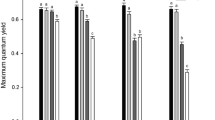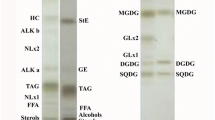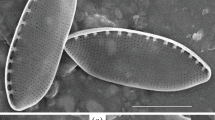Abstract
Phytoplankton species were grown in batch cultures in the presence of the water-soluble fraction (WSF; 50 and 100%) of a Mexican crude oil (Isthmus Cactus). The algae exhibited various responses ranging from retarded growth to stimulation of growth. The cellular content of chlorophylla and the lipid composition of the algae were examined. Four algae, the bacillariophytesNitzschia closterium andAsterionella glacialis, the cryptophytesRhodomonas lens, and the chlorophyteDunaliella tertiolecta, exhibited retarded growth. In most of these algae, cellular chlorophylla, lipid pigments, glycolipids and triglycerides decreased whereas sterols and hydrocarbons accumulated. Phospholipids did not exhibit any specific pattern of change during the experiments. The cyanophyteAgmenellum quadruplicatum and the bacillariophyteSkeletonema costatum were less sensitive to the WSF. The cell yield of the dinophyteProrocentrum minimum was stimulated by the WSF. In these three latter species, lipid pigments were enhanced or remained at control levels. We concluded that the toxic effect of the WSF disrupts the biosynthesis mechanisms required for a functional photosynthetic apparatus (biosynthesis of chlorophylla, glycolipids and lipid pigments) in sensitive algae, a phenomenon coupled to sterol accumulation in these algae.
Similar content being viewed by others
Literature cited
Antia, N. J., Cheng, J. Y. (1970). The survival of axenic culture of marine phytoplanktonic algae after prolonged exposure to darkness at 20°C. Phycologia 9: 179–183
Ballantine, J. A., Lavis, A., Morris, R. J. (1979). Sterols of the phytoplankton. Effects of illumination and growth stage. Phytochem. 18: 1459–1466
Batterton, J. C., Winters, K., Van Baalen, C. (1978). Sensitivity of three microalgae to crude oils and fuel oils. Mar. envirl Res. 1: 31–41
Bligh, E. G., Dyer, W. J. (1959). A rapid method of total lipid extraction and purification. Can. J. Biochem. Physiol. 37: 911–917
Boutry, J. L., Barbier, M., Ricard, M. (1976). La diatoméeChaetoceros simplex calcitrans Poulsen et son envirionnement. II. Effets de la lumière et des irradiations ultra-violettes sur la production primaire et la biosynthèse des stérols. J. exp. mar. Biol. Ecol. 21: 69–74
Boylan, D. B., Tripp, B. W. (1971). Determination of hydrocarbons in sea water extracts of crude oil and crude oil fractions. Nature, Lond. 230: 44–47
Connell, D. W., Miller, G. J. (1980). Petroleum hydrocarbons in aquatic ecosystems. Behaviour and effects of sublethal concentration. CRC critical Rev. envir. Control 11: 37–104
Corner, E. D. S. (1978). Pollution studies with marine plankton. Part I. Petroleum hydrocarbons and related compounds. Adv. mar. Biol. 16: 289–379
Delmas, R. P., Parrish, C. C., Ackman, R. G. (1984). Determination of lipid class concentrations in sea water by thin-layer chromatography with flame ionization detection. Analyt. Chem. 56: 1272–1277
James, A. T., Nichols, B. W. (1966). Lipids of photosynthetic systems. Nature, Lond. 372–375
Jones, G. J., Nichols, P. D., Jones, R. B. (1983). The lipid composition ofThoracosphaera heimii: evidence for inclusion in the Dinophyceae. J. Phycol. 19: 416–420
Karydis, M., Fogg, G. E. (1980). Physiological effects of hydrocarbons on the marine diatomCyclotella cryptica. Microb. Ecol. 6: 281–290
Kates, M., Volcani, B. E. (1966). Lipids components of diatoms. Biochim. biophys. Acta 116: 264–278
Le Fèvre, J. (1979). On the hypothesis of a relationship between dinoflagellate blooms and the “Amoco-Cadiz” oil spill. J. mar. biol. Ass. U. K. (short notes) 59: 525–528
Lee, R. F., Takahashi, M., Beers J. (1978). Short term effects of oil on plankton in controlled ecosystems. Proceedings of Conference on Assessment of Ecological Impacts of Oil Spills, 14–17 June 1978. American Institute of Biological Sciences, New York
Lin, D. S., Ilias, A. M., Connor, W. E., Caldwell, R. S., Cory, H. T., Daves, G. D. (1982). Composition and biosynthesis of sterols in selected marine phytoplankton. Lipids 17: 818–824
Lorenzen, C. J. (1966). A method for the continous measurement ofin vivo chlorophyll concentration. Deep-Sea Res. 13: 223–227
Lynch, D. V., Thompson, G. A. (1984). Chloroplast phospholipid molecular species alterations during low temperature acclimation inDunaliella. Pl. Physiol. 74: 198–203
Morris, R. J. (1984). Studies of a spring phytoplankton bloom in an enclosed experimental ecosystem. II. Changes in the component fatty acids and sterols. J. exp. mar. Biol. Ecol. 75: 59–70
Morris, R. J., MacCartney, M. J., Joint, I. R., Robinson, G. A. (1986). Further studies of a spring phytoplankton bloom in an enclosed experimental ecosystem. J. exp. mar. Biol. Ecol. 86: 151–170
Nichols, P. D., Jones, G. J., de Leeuw, J. W., Jones, R. B. (1984). The fatty acids and sterol composition of two marine dinoflagellates. Phytochem. 23: 1043–1047
O'Brien, P. Y., Dixon, P. S. (1976). The effects of oils and oil components on algae: review. Br. phycol. J. 11: 115–142
Opute, F. I. (1974a). Physiological studies on the phospholipids of diatoms. J. exp. Bot. 25: 810–822
Opute, F. I. (1974b). Lipid and fatty acid composition of diatoms. J. exp. Bot. 25: 823–835
Orcutt, D. M., Patterson, G. W. (1975). Sterol, fatty acid and elemental composition of diatoms grown in chemically defined media. Comp. Biochem. Physiol. 50B: 579–583
Paasche, E., Bryceson, I., Tangen, K. (1984). Interspecific variation in dark nitrogen uptake by dinoflagellates. J. Phycol. 20: 394–401
Parrish, C. C., Ackman, R. G. (1983). Chromarod separations for the analysis of marine lipid classes by Iatroscan thin-layer chromatography flame ionization detection. J. Chromat. 262: 103–112
Patterson, G. W. (1971). The distribution of sterols in algae. Lipids 6: 120–127
Patterson, G. W. (1974). Sterols of some green algae. Comp. Biochem. Physiol. 47B: 453–457
Rosenberg, A., Gouaux, J. (1967). Quantitative and compositional changes in monogalactosyl and digalactosyl diglycerids during light-induced formation of chloroplasts inEuglena gracilis. J. Lipid Res. 8: 80–83
Schifrin, N. S., Chisholm, S. W. (1981). Phytoplankton lipids: interspecific differences and effects of nitrate, silicate and light-dark cycle. J. Phycol. 17: 374–384
Smith, J. E. (1968). Torrey Canyon pollution and marine life. Cambridge University Press, London
Stern, A. I., Schiff, J. A., Klein, H. P. (1960). Isolation of ergosterol fromEuglena gracilis; distribution among mutant strains. J. Protozool. 7: 52–55
Vandermeulen, J. H., Ahern, T. P. (1976). Effects of petroleum on algal physiology: review and progress report. In: Lockwood, A. P. M. (ed.) Effects of pollutants on aquatic organisms. Cambridge University Press, p. 107–125
Vestal, J. R., Cooney, J. J., Crow, S., Berger, J. (1984). Effects of hydrocarbons on microorganisms. In: Atlas, R. M. (ed.) Petroleum microbiology. MacMillan Press, New York, p. 475–506
Volkman, J. K., Gagosian, R. B., Wakeham, S. G. (1984). Free and esterified sterols of the marine dinoflagellateGonyaulax polygramma. Lipids 19: 457–465
Winters, K., O'Donnell, R., Batterton, J. C., Van Baalen, C. (1976). Water-soluble components of four fuel oils: chemical characterization and effects on growth of microalgae. Mar. Biol. 36: 269–276
Winters, K., Van Baalen, C., Nicol, J. A. C. (1977). Water-soluble extractives from petroleum oils: chemical characterization and effects on microalgae and marine animals. Rapp. P.-v. Réun. Cons. perm. int. Explor. Mer 171: 166–174
Yentsch, C. S., Menzel, D. W. (1963). A method for the determination of the phytoplankton, chlorophyll and phaeophytin by fluorescence. Deep-Sea Res. 10: 221–231
Author information
Authors and Affiliations
Additional information
Communicated by J. M. Pérès, Marseille
Rights and permissions
About this article
Cite this article
Morales-Loo, M.R., Goutx, M. Effects of water-soluble fraction of the Mexican crude oil “Isthmus Cactus” on growth, cellular content of chlorophylla, and lipid composition of planktonic microalgae. Mar. Biol. 104, 503–509 (1990). https://doi.org/10.1007/BF01314357
Accepted:
Issue Date:
DOI: https://doi.org/10.1007/BF01314357




